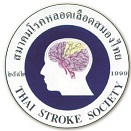Outcomes of dual antiplatelet therapy in ischemic stroke or transient ischemic attack patients with tandem carotid artery stenosis or carotid artery occlusion
Keywords:
carotid artery occlusion, dual antiplatelet, stroke, tandem carotid artery stenosisAbstract
Background and objective: Carotid artery stenosis is one of the causes of ischemic stroke. However, some ischemic stroke or transient ischemic attack patients with carotid artery stenosis cannot be performed carotid endarterectomy due to the characteristic of carotid artery lesion. Dual antiplatelet therapy was shown to reduce the rate of recurrence of ischemic stroke. The objective of this study was to determine the outcomes of dual antiplatelet therapy in ischemic stroke or transient ischemic attack patients with tandem carotid artery stenosis or occlusion.
Materials and Methods: This retrospective cohort study examined the clinical, imaging data and clinical outcomes of ischemic stroke or transient ischemic attack patients with tandem carotid artery stenosis or occlusion. Univariate analysis and multiple logistic regression model of included relevant confounders and potential predictors were performed.
Results: Patients who received single antiplatelet therapy had higher risk of recurrent ischemic stroke or transient ischemic attack than patients who received dual antiplatelet therapy at 12-months follow-up (odd ratio (OR), 0.67; confidence interval (95%CI), 0.26-0.98; p=0.029) but not significance in number of death (OR, 0.86; 95%CI, 0.32-39.49; p=0.556). The rate of extracranial bleeding events was higher in dual antiplatelet group than in single antiplatelet group (10.7% versus 5.3% (OR, 3.33; 95%CI, 1.88-5.80; p=<0.001)).
Conclusion: Ischemic stroke or transient ischemic attack patients with tandem carotid artery stenosis or occlusion have potential clinical benefit from dual antiplatelet therapy with increase in the risk of minor extracranial bleeding.
References
2. Bryant MF. Anatomic considerations in carotid endarterectomy. Surg Clin North Am 1974;54:1291–6.
3. HansS, Shah S, Hans B. Carotid endarterectomy for high plaques. Am J Surg 1989;157:431–4.
4. Day AL, Rhoton Air, Quisling RG. Resolving siphon stenosis following endarterectomy. Stroke 1980;11:278-81.
5. Fields WS. Selection of stroke patients for arterial reconstructive surgery. Am I Surg 1973;125:527-9.
6. Marzewski DH, Fttrlan AJ, St Louis P, Little JR, Modic MT, Williams G. Intracranial internal carotid artery stenosis: long-term prognosis. Stroke 1982;13:821-4.
7. Markus HS, Droste DW, Kaps M, Larrue V, Lees KR, Siebler M, et al. Dual antiplatelet therapy with clopidogrel and aspirin in symptomatic carotid stenosis evaluated using doppler embolic signal detection: the Clopidogrel and Aspirin for Reduction of Emboli in Symptomatic Carotid Stenosis. Circulation 2005;111(17):2233-40.
8. Wang Y, Zhao X, Liu L, Wang D, Wang C, Li H, et al. Clopidogrel with aspirin in acute minor stroke or transient ischemic attack. N Engl J Med 2013;369(1):11-9.
9. Johnston SC, Rothwell PM, Nguyen-Huynh MN, Giles MF, Elkins JS, Bernstein AL, et al. Validation and refinement of scores to predict very early stroke risk after transient ischaemic attack. Lancet 2007;369: 283-92.
10. North American Symptomatic Carotid Endarterectomy Trial Collaborators. Beneficial effect of carotid endarterectomy in symptomatic patients with high-grade carotid stenosis. N Engl J Med 1991;325:445–453.
11. Mughal MM, Khan MK, DeMarco JK, Majid A, Shamoun F, Abela GS. Symptomatic and asymptomatic carotid artery plaque. Expert review of cardiovascular therapy 2011;9(10):1315-30.
12. Markus HS, Droste DW, Kaps M, Larrue V, Lees KR, Siebler M, et al. Dual antiplatelet therapy with clopidogrel and aspirin in symptomatic carotid stenosis evaluated using doppler embolic signal detection: the Clopidogrel and Aspirin for Reduction of Emboli in Symptomatic Carotid Stenosis.
Circulation 2005;111(17):2233-40.
13. Bernard R. Fundamentals of biostatistics (5thed.). Duxbery:Thomson learning, 384-385.
14. Markus HS, Droste DW, Kaps M, Larrue V, Lees KR, Siebler M, et al. Dual antiplatelet therapy with clopidogrel and aspirin in symptomatic carotid stenosis evaluated using doppler embolic signal detection: the Clopidogrel and Aspirin for Reduction of Emboli in Symptomatic Carotid Stenosis (CARESS) trial. Circulation 2005;111(17):2233-40.
15. Wang Y, Zhao X, Liu L, Wang D, Wang C, Li H, et al. Clopidogrel with aspirin in acute minor stroke or transient ischemic attack (CHANCE) trial. N Engl J Med 2013;369(1):11-9.
16. Johnston SC, Easton JD, Farrant M, Barsan W, Conwit RA, Elm JJ, et al. Clopidogrel and Aspirin in Acute Ischemic Stroke and HighRisk TIA. N Engl J Med 2018;379(3):215-25.
17. Grubb RL Jr, Derdeyn CP, Fritsch SM, Carpenter DA, Yundt KD, Videen TO, et al. Importance of hemodynamic factors in the prognosis of symptomatic carotid occlusion. JAMA 1998;280:1055–1060.
18. Bogousslavsky J, Regli F. Borderzone infarctions distal to internal carotid artery occlusion: prognostic implications. Ann Neurol 1986;20:346– 350.
19. Pessin MS, Hinton RC, Davis KR, Duncan GW, Roberson GH, Ackerman RH, et al. Mechanisms of acute carotid stroke. Ann Neurol 1979;6:245–252.
20. Wijman CA, Babikian VL, Matjucha IC, Koleini B, Hyde C, Winter MR, et al. Cerebral microembolism in patients with retinal ischemia. Stroke 1998; 29:1139–1143.
21. Caplan LR, Hennerici M. Impaired clearance of emboli (washout) is an important link between hypoperfusion, embolism, and ischemic stroke. Arch Neurol 1998;55:1475–1482.
22. Caplan LR, Wong KS, Gao S, Hennerici MG. Is hypoperfusion an important cause of strokes? If so, how? Cerebrovasc Dis 2006;21:145–153.
23. Delcker A, Diener HC, Wilhelm H. Source of cerebral microembolic signals in occlusion of the internal carotid artery. J Neurol 1997;244:312–317.
24. Barnett HJ, Peerless SJ, Kaufmann JC. “Stump” on internal carotid artery–a source for further cerebral embolic ischemia. Stroke 1978;9:448–456.
25. Georgiadis D, Grosset DG, Lees KR. Transhemispheric passage of microemboli in patients with unilateral internal carotid artery occlusion. Stroke 1993;24:1664–1666.
26. Klijn CJ, Kappelle LJ, Algra A, van Gijn J. Outcome in patients with symptomatic occlusion of the internal carotid artery or intracranial arterial lesions: a meta-analysis of the role of baseline characteristics and type of antithrombotic treatment. Cerebrovasc Dis 2001;12:228–234.
Downloads
Published
How to Cite
Issue
Section
License
ข้อความภายในบทความที่ตีพิมพ์ในวารสารสมาคมโรคหลอดเลือดสมองไทยเล่มนี้ ตลอดจนความรับผิดชอบด้านเนื้อหาและการตรวจร่างบทความเป็นของผู้นิพนธ์ ไม่เกี่ยวข้องกับกองบรรณาธิการแต่อย่างใด การนำเนื้อหา ข้อความหรือข้อคิดเห็นของบทความไปเผยแพร่ ต้องได้รับอนุญาตจากกองบรรณาธิการอย่างเป็นลายลักษณ์อักษร ผลงานที่ได้รับการตีพิมพ์ในวารสารเล่มนี้ถือเป็นลิขสิทธิ์ของวารสาร





